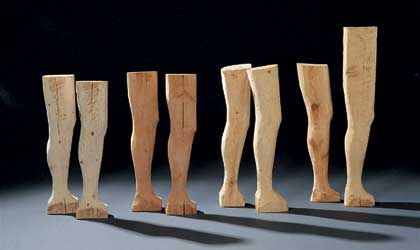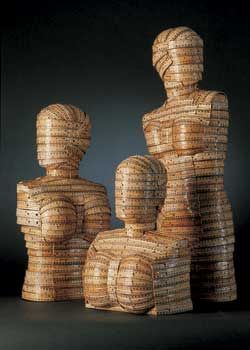By Dottie Indyke
 A conceptual mixed-media artist of Creek-Euchee heritage gains notice
A conceptual mixed-media artist of Creek-Euchee heritage gains notice
Weighing in at 60 pounds, Steven Deo’s sculpture global war is a solid sphere of 7,500 toy soldiers. From a distance, it’s a replica of Earth, with white continents afloat on blue oceans; up close, it’s chaos, with jutting plastic body parts and guns pointing in all directions.
Deo, who was born in Claremore, OK, of Creek and Euchee descent, is a master at transforming mundane objects into art, along the way appending layers of meaning. Sometimes, as with global war, his purpose is political. Often, it is playful—witness his animals built of puzzle pieces. Using such diverse materials as the soles of shoes, bent rulers, dice, and encyclopedias in his artwork, he has commented on everything from society’s judgment of women’s bodies to the diseases that European settlers brought to the New World.
Partly from childhood experience, Deo finds beauty in materials that others think forgettable, whether they be the glassy surface of a golf tee or the malleability of a stick of chewing gum. Poverty forced his family to be creative; he recalls his grandparents turning tuna cans into drums and boot leather into door hinges years ago.
 Increasingly a conceptual artist, the 49-year-old, who is these days a resident of Albuquerque, NM, last year received a coveted Joan Mitchell Foundation grant to further his artistic career. But he started out as a painter of traditional Creek imagery. In the early 1990s, while he was a student at the Institute of American Indian Arts, he took a hard look at his output. “I wasn’t really making a connection with my artwork,” he says, looking back. “I’ve never ridden a horse or shot a buffalo.”
Increasingly a conceptual artist, the 49-year-old, who is these days a resident of Albuquerque, NM, last year received a coveted Joan Mitchell Foundation grant to further his artistic career. But he started out as a painter of traditional Creek imagery. In the early 1990s, while he was a student at the Institute of American Indian Arts, he took a hard look at his output. “I wasn’t really making a connection with my artwork,” he says, looking back. “I’ve never ridden a horse or shot a buffalo.”
Deo’s search for a more authentic form of expression led him to the San Francisco Art Institute, where he was overjoyed by the smell of paint and turpentine and by paintings he knew he would learn to understand. He graduated as an honor student and took with him an enlarged perspective on art and further insight into his own identity.
Another turning point came in 2000, when he took a job as preparator for the Museum of Modern Art in New York City. “I got to see art made with so many materials,” he recollects. “It loosened me up to not worry so much about how it might be preserved or how things might go together.”
Working in his studio afterward, he got to thinking about how his shoes had seen him through years of travel, from New Mexico to California to New York and back. Around the same time, he happened on a cache of shoes that had belonged to his grandparents. Lined up, they reminded him of the Creeks’ traditional stomp dance. He began collecting shoes, separating the tops from the bottoms in a quest for soles. The word and the object spoke to him, suggesting the spirits of his ancestors and their life journeys. His 2005 artwork entitled sole city stars a cast of diverse characters—cheerleaders, young people jogging, elderly people walking dogs—all made from the soles of shoes.
Another mixed-media piece, dance of the woods, is a procession of truncated legs roughly carved from ponderosa pine. The legs seem to move forward as if connected to invisible bodies. For Deo, they evoke Creek ceremony as well as the amputations caused by diabetes, a disease all too common among Native Americans. The installation is part of Migrations: New Directions in Native American Art, a University of New Mexico exhibit that will travel beginning next year.
Lately, Deo has become obsessed with rulers, sculpting linked chains and torsos of women swathed in measuring sticks. Buying rulers by the caseload, he sands, boils, and bends them around pipes to create curved shapes, then lets them bake in the piercing New Mexico sun. Despite their armor, the busts are strangely expressive. Inspired by the construction of canoes, Deo was initially attracted to the linear aesthetic of interlocking strips of wood. Only later did it occur to him that he was a making a statement about Western culture’s inclination to judge women’s physical appearances.
Whenever his creative well runs dry, Deo finds renewal in teaching. Recently, he and his pupils hit the streets, collecting glass shards and cigarette butts and turning them into works of art. Interacting with students and thinking on his feet, he says, always generates a flood of new ideas.
Deo is represented by Lois Lambert Gallery, Santa Monica, CA; Thirteen Moons Gallery, Santa Fe, NM; and the Institute of American Indian Arts Museum, Santa Fe, NM.
Featured in “Native Arts” June 2006





